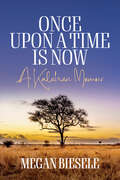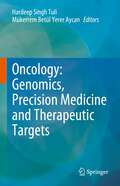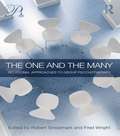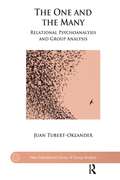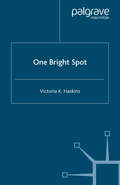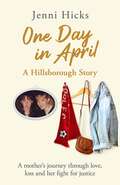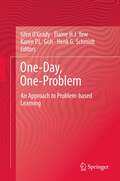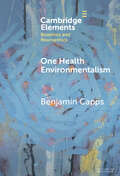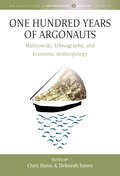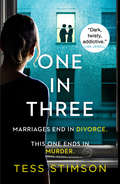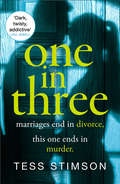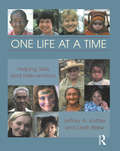- Table View
- List View
Once Upon a Time is Now: A Kalahari Memoir
by Megan BieseleFifty years after her first fieldwork with Ju/'hoan San hunter-gatherers, anthropologist Megan Biesele has written this exceptional memoir based on personal journals she wrote at the time. The treasure trove of vivid learning experiences and nightly ponderings she found has led to a memoir of rare value to anthropology students and academics as well as to general readers. Her experiences focus on the long-lived healing dance, known to many as the trance dance, and the intricate beliefs, artistry, and social system that support it. She describes her immersion in a creative community enlivened and kept healthy by that dance, which she calls "one of the great intellectual achievements of humankind." From the Preface: A few years ago I finally got around to looking back into the box of personal field journals I had not opened for over forty years. I found a treasure trove. It was an overwhelming experience. So much that I had forgotten came vividly alive: I laughed, wept, and was terrified all over again at my temerity in taking on what I had taken on. To do justice to the richness of these notebooks, I realized, I would have to do a completely different sort of writing from anything I had ever done before.
Once Upon a Time is Now: A Kalahari Memoir
by Megan BieseleFifty years after her first fieldwork with Ju/'hoan San hunter-gatherers, anthropologist Megan Biesele has written this exceptional memoir based on personal journals she wrote at the time. The treasure trove of vivid learning experiences and nightly ponderings she found has led to a memoir of rare value to anthropology students and academics as well as to general readers. Her experiences focus on the long-lived healing dance, known to many as the trance dance, and the intricate beliefs, artistry, and social system that support it. She describes her immersion in a creative community enlivened and kept healthy by that dance, which she calls "one of the great intellectual achievements of humankind." From the Preface: A few years ago I finally got around to looking back into the box of personal field journals I had not opened for over forty years. I found a treasure trove. It was an overwhelming experience. So much that I had forgotten came vividly alive: I laughed, wept, and was terrified all over again at my temerity in taking on what I had taken on. To do justice to the richness of these notebooks, I realized, I would have to do a completely different sort of writing from anything I had ever done before.
Oncology: Genomics, Precision Medicine and Therapeutic Targets
by Hardeep Singh Tuli Mükerrem Betül Yerer AycanThis book describes translational cancer therapeutics and the way forward from clinical and molecular diagnosis to treatment. In addition, genomics alterations, microRNAs, and long non-coding RNAs translate precision medicine for the individualistic therapy of cancer patients. It describes the involvement of various pharmacogenetic factors in pharmacodynamic/pharmacokinetic (PD/PK) modulations of medicines. Indeed, the role of bioinformatics and biostatistics, considering the extensive data analysis serving precision medicine approaches, has also been entertained in the present book. Therefore, intended book demonstrates the successful medical evidence for the use of precision medicine in the treatment of cancer and its future clinical perspectives. It fills the gaps in cancer biology and precision medicine with its up-to-date content and well-designed chapters. It will serve as a valuable resource for science, medical students, and interdisciplinary researchers. It is a very welcome addition for the scientific community, research centers, and university-industry research collaborators to find out a complete capsular package about cancer drug targets, precision, and personalized medicine (including an introduction to cancer cell signaling, genomic alterations, miRNA targeting, pharmacogenetics, biomarkers, and metabolomics in precision medicine, etc.) at a single platform.
The One and the Many: Relational Approaches to Group Psychotherapy (Psychoanalysis in a New Key Book Series)
by Robert Grossmark Fred WrightThe One and the Many: Relational Approaches to Group Psychotherapy applies advances in relational psychoanalysis to the theory and practice of group psychotherapy. In this volume Robert Grossmark and Fred Wright bring together leading writers in the group psychotherapy field, both psychoanalysts and group therapists, who have integrated ideas from contemporary relational psychoanalysis. Together, they constitute a vibrant and dynamic new wave in group psychotherapy and psychoanalysis that challenge much accepted wisdom and practice in the field, including classic group psychotherapy ideas regarding the therapist’s role, the group-as-a-whole and unconscious processes in group. In this book, Grossmark and Wright show how the development of relational psychoanalysis has had a transformative impact on the field of psychoanalysis that has reverberated in the group psychotherapy world. The contributors illustrate how the broadening scope of the contemporary relational scene offers much that coheres with and amplifies the theory and practice of group treatment. The focus on dissociation, enactment, trauma, mutuality and intersubjectivity in the clinical setting, the foregrounding of sub-symbolic communication and implicit relational knowing, the registration of mutual containment and mutual regulation, all open new and exciting vistas for understanding the process and healing properties of group treatment. The One and The Many expands the theory and practice of group psychotherapy offering innovative and refreshing ways to understand group interaction and to formulate interventions in both large and small groups. This book will be of interest and practical help to all who practice group psychotherapy, group process, psychoanalysis and psychotherapy in general, including all mental health practitioners, psychoanalysts, psychotherapists, psychiatrists, social workers, counsellors and pastoral counsellors.
The One and the Many: Relational Approaches to Group Psychotherapy (Psychoanalysis in a New Key Book Series)
by Robert Grossmark Fred WrightThe One and the Many: Relational Approaches to Group Psychotherapy applies advances in relational psychoanalysis to the theory and practice of group psychotherapy. In this volume Robert Grossmark and Fred Wright bring together leading writers in the group psychotherapy field, both psychoanalysts and group therapists, who have integrated ideas from contemporary relational psychoanalysis. Together, they constitute a vibrant and dynamic new wave in group psychotherapy and psychoanalysis that challenge much accepted wisdom and practice in the field, including classic group psychotherapy ideas regarding the therapist’s role, the group-as-a-whole and unconscious processes in group. In this book, Grossmark and Wright show how the development of relational psychoanalysis has had a transformative impact on the field of psychoanalysis that has reverberated in the group psychotherapy world. The contributors illustrate how the broadening scope of the contemporary relational scene offers much that coheres with and amplifies the theory and practice of group treatment. The focus on dissociation, enactment, trauma, mutuality and intersubjectivity in the clinical setting, the foregrounding of sub-symbolic communication and implicit relational knowing, the registration of mutual containment and mutual regulation, all open new and exciting vistas for understanding the process and healing properties of group treatment. The One and The Many expands the theory and practice of group psychotherapy offering innovative and refreshing ways to understand group interaction and to formulate interventions in both large and small groups. This book will be of interest and practical help to all who practice group psychotherapy, group process, psychoanalysis and psychotherapy in general, including all mental health practitioners, psychoanalysts, psychotherapists, psychiatrists, social workers, counsellors and pastoral counsellors.
The One and the Many: Relational Psychoanalysis and Group Analysis (The New International Library of Group Analysis)
by Juan Tubert-OklanderThis book presents a selection of papers on the subjects of Relational Analysis and Group Analysis, written in the ten-year period that goes from 2002 to 2012. It deals with the problems of interpretation from the hermeneutic, psychoanalytic, and group-analytic points of view.
The One and the Many: Relational Psychoanalysis and Group Analysis (The New International Library of Group Analysis)
by Juan Tubert-OklanderThis book presents a selection of papers on the subjects of Relational Analysis and Group Analysis, written in the ten-year period that goes from 2002 to 2012. It deals with the problems of interpretation from the hermeneutic, psychoanalytic, and group-analytic points of view.
One Breath Apart: Facing Dissection
by Sandra L BertmanWhat started in the mid-seventies as brown-bag lunchtime optional seminars for students, faculty, and staff of the (then) University of Massachusetts Medical Center evolved into a magnificent project. The medical students' courageous willingness to acknowledge their feelings about death and dissection has made this book possible. It is our hope that this slim volume - this collection of words and images created by the medical students at University of Massachusetts during the last thirty years (and augmented by Meryl Levin's documentary photographs of students from Weill Medical College of Cornell University and their journal entries written in 1998 and published in "Anatomy of Anatomy") - will provide you with what good doctors provide for their patients: catharsis, personal insights, and support. From the Foreword: 'One of the enduring images of my first year in medical school is the narrow, unshaven face of Ernest, the cadaver I shared with three classmates whose names I can't remember. We named him 'Ernest', so we could impress our parents by telling them how we were working in dead earnest. In reality, like most cadavers in those days, he was an anonymous indigent man who died in the county home and whose remains were used for our education without his consent. My group was considered lucky because cancer had burned away every bit of Ernest's fat, thus making him an excellent 'specimen' for dissection. Even then I knew that Ernest was more than a specimen, but it took a long time to understand that he was actually my first mentor in the joys and sorrows and successes and failures of medicine. Surprisingly, it was Ernest rather than my basic science professors - the living ones, that is - who provoked the most important questions about what it means to be a doctor and forced me to confront them. As I recall, though, this was a solitary process because my classmates and I never discussed, or perhaps even admitted to ourselves, our feelings of ambivalence, fear, pain, gratitude, and exultation, or the changes in us as persons during the first year of medical school. We tried to hide all this because at the time that's what doctors were supposed to do. Today things are different. As students at UMass, you are especially privileged to have a module like "One Breath Apart" integrated into your anatomy experience. This module provides you the opportunity to explore and share your personal responses to dissection, and with this publication it gives you access to an additional resource: a splendid introduction to the written and visual tradition established by UMass students over the last two decades, along with evocative photographs and journal entries from the medical students at Cornell, documented by Meryl Levin in "Anatomy of Anatomy". As I read through this book, I was struck by the Nancy Long's title poem. She writes, 'I pretended you were here/To teach me the details'. How reminiscent of my own experience those words are! 'Then I saw your face/And I knew...' That's the turning point. As physicians we can either embark on the journey of learning to see others' faces and to hold their hands, or we can attempt to distance ourselves and focus only on 'details'. This is a decision that every medical student must make, and our cadavers present the first difficult challenge. In a 2006 class poem, UMass students wrote, 'We felt the brain/And imagined its power to create. We held the heart/And imagined its ability to embrace'. These words represent an affirmation of empathy and compassion over detachment. One of the most compelling images of "One Breath Apart" shows the anatomy cadaver as a bridge spanning the chasm that lies between ignorance, darkness, and death on one side and knowledge, health, and life on the other. Dozens of tiny figures march across the span. Like me, they won't forget the backbone of that bridge. As another UMass student writes, 'I know that I will be irrevocably altered" - Jack Coulehan, M.D., Professor of Medicine, Stoney Brook University, NY.
One Breath Apart: Facing Dissection
by Sandra L BertmanWhat started in the mid-seventies as brown-bag lunchtime optional seminars for students, faculty, and staff of the (then) University of Massachusetts Medical Center evolved into a magnificent project. The medical students' courageous willingness to acknowledge their feelings about death and dissection has made this book possible. It is our hope that this slim volume - this collection of words and images created by the medical students at University of Massachusetts during the last thirty years (and augmented by Meryl Levin's documentary photographs of students from Weill Medical College of Cornell University and their journal entries written in 1998 and published in "Anatomy of Anatomy") - will provide you with what good doctors provide for their patients: catharsis, personal insights, and support. From the Foreword: 'One of the enduring images of my first year in medical school is the narrow, unshaven face of Ernest, the cadaver I shared with three classmates whose names I can't remember. We named him 'Ernest', so we could impress our parents by telling them how we were working in dead earnest. In reality, like most cadavers in those days, he was an anonymous indigent man who died in the county home and whose remains were used for our education without his consent. My group was considered lucky because cancer had burned away every bit of Ernest's fat, thus making him an excellent 'specimen' for dissection. Even then I knew that Ernest was more than a specimen, but it took a long time to understand that he was actually my first mentor in the joys and sorrows and successes and failures of medicine. Surprisingly, it was Ernest rather than my basic science professors - the living ones, that is - who provoked the most important questions about what it means to be a doctor and forced me to confront them. As I recall, though, this was a solitary process because my classmates and I never discussed, or perhaps even admitted to ourselves, our feelings of ambivalence, fear, pain, gratitude, and exultation, or the changes in us as persons during the first year of medical school. We tried to hide all this because at the time that's what doctors were supposed to do. Today things are different. As students at UMass, you are especially privileged to have a module like "One Breath Apart" integrated into your anatomy experience. This module provides you the opportunity to explore and share your personal responses to dissection, and with this publication it gives you access to an additional resource: a splendid introduction to the written and visual tradition established by UMass students over the last two decades, along with evocative photographs and journal entries from the medical students at Cornell, documented by Meryl Levin in "Anatomy of Anatomy". As I read through this book, I was struck by the Nancy Long's title poem. She writes, 'I pretended you were here/To teach me the details'. How reminiscent of my own experience those words are! 'Then I saw your face/And I knew...' That's the turning point. As physicians we can either embark on the journey of learning to see others' faces and to hold their hands, or we can attempt to distance ourselves and focus only on 'details'. This is a decision that every medical student must make, and our cadavers present the first difficult challenge. In a 2006 class poem, UMass students wrote, 'We felt the brain/And imagined its power to create. We held the heart/And imagined its ability to embrace'. These words represent an affirmation of empathy and compassion over detachment. One of the most compelling images of "One Breath Apart" shows the anatomy cadaver as a bridge spanning the chasm that lies between ignorance, darkness, and death on one side and knowledge, health, and life on the other. Dozens of tiny figures march across the span. Like me, they won't forget the backbone of that bridge. As another UMass student writes, 'I know that I will be irrevocably altered" - Jack Coulehan, M.D., Professor of Medicine, Stoney Brook University, NY.
One Bright Spot
by V. HaskinsFor every Aboriginal child taken away by the state governments in Australia, there was at least one white family intimately involved in their life. One Bright Spot is about one of these families - about 'Ming', a Sydney wife and mother who hired Aboriginal domestic servants in the 20s and 30s, and became an activist against the Stolen Generations policy. Her story, reconstructed by her great-granddaughter, tells of a remarkable, yet forgotten, shared history.
One Day in April – A Hillsborough Story: A mother’s journey through love, loss and her fight for justice
by Jenni HicksOn the morning of Saturday 15 April 1989, Jenni Hicks, her husband, and their two teenage daughters, Sarah and Vicki, went to watch a football match. That was to be their last day as a family. Sarah and Vicki didn't come home, and Jenni's world was changed forever. Since that fateful day, Jenni has tirelessly campaigned for justice for her own and others' families. But this is not the story of the Hillsborough tragedy. This is a story of what came before and after that day: of a mother's love, her unimaginable bravery, a flame of hope that never died, and a quest for justice that has lasted three decades. It is a journey that has taken her from Allerton Cemetery to the Courts of Appeal, from the depths of despair to meetings with Prime Ministers and royalty.With the final court cases coming to a conclusion in spring 2021, Jenni's role as the longest-serving committee member of the Hillsborough Family Support Group is coming to an end - and she can finally give herself permission to grieve solely as a mother, rather than as a campaigner. One Day In April is the first time that Jenni has spoken about her story in full, and is a unique and poignant tribute to the lives that Sarah and Vicki lost, and the final word from the extraordinary mother they left behind.
One-Day, One-Problem: An Approach to Problem-based Learning
by Glen O'Grady, Elaine H.J. Yew, Karen P.L. Goh and Henk G. SchmidtOne-day, one-problem is a unique adaptation of problem-based learning (PBL) pioneered at Republic Polytechnic, Singapore. Here students are challenged each day with a problem from their domain and attain the necessary learning outcomes in the process of responding to the problem. Throughout the day students would engage in small group discussions, self-directed learning and conversations with their teacher who plays the role of a facilitator. This approach to learning and instruction represents a new brand of constructivist learning in a more structured learning environment compared to conventional PBL. This book contains a series of chapters by authors with first-hand experience in the One-day,one-problem PBL approach. Unlike other books on PBL, the chapters are both research-informed and practical. Results of empirical studies into the factors of PBL such as quality of problems, tutor behaviours, scaffoldings, student learning and interest are discussed together with practical implications for the educator.The book begins with an overview of the one-day, one-problem process, providing a viewpoint from both the student and tutor. Republic Polytechnic’s pedagogical philosophy and epistemological belief of education are introduced with the intent to share how the polytechnic designed and implemented a system that supports the philosophical beliefs. Results and practical implications of empirical studies on the various factors that influence students’ learning in PBL are discussed. These include the quality of problems and the use of scaffoldings for students’ learning, tutors as facilitators, preparation of staff for PBL, student assessment, how students learn in the process of PBL and student interest.
One Health Environmentalism (Elements in Bioethics and Neuroethics)
by null Benjamin CappsOne Health emerges from the contingent scientific, social, and political realities of environmentalism. The concept mixes the land, sea, and sky with geopolitics on the global stages of the United Nations and World Health Organization. It inspires new investment in conservation and public health, motivates interdisciplinary collaboration, and in practice implicates green economies and animal law as well. This Element does not tackle all of this but attempts to situate One Health in the catastrophe of COVID-19; a socio-ecological upheaval prophetic of the inevitable next pandemic evolving from planetary climate crisis of our own making. One Health Environmentalism argues that humanity's future depends upon extending an olive branch to biotic communities, by being less speciesist and less blind to the rights in nature.
One Hour in Paris: A True Story of Rape and Recovery
by Karyn L. FreedmanIn this powerful memoir, philosopher Karyn L. Freedman travels back to a Paris night in 1990 when she was twenty-two and, in one violent hour, her life was changed forever by a brutal rape. One Hour in Paris takes the reader on a harrowing yet inspirational journey through suffering and recovery both personal and global. We follow Freedman from an apartment in Paris to a French courtroom, then from a trauma center in Toronto to a rape clinic in Africa. At a time when as many as one in three women in the world have been victims of sexual assault and when many women are still ashamed to come forward, Freedman’s book is a moving and essential look at how survivors cope and persevere. At once deeply intimate and terrifyingly universal, One Hour in Paris weaves together Freedman’s personal experience with the latest philosophical, neuroscientific, and psychological insights on what it means to live in a body that has been traumatized. Using her background as a philosopher, she looks at the history of psychological trauma and draws on recent theories of posttraumatic stress disorder and neuroplasticity to show how recovery from horrific experiences is possible. Through frank discussions of sex and intimacy, she explores the consequences of sexual violence for love and relationships, and she illustrates the steep personal cost of sexual violence and the obstacles faced by individual survivors in its aftermath. Freedman’s book is an urgent call to face this fundamental social problem head-on, arguing that we cannot continue to ignore the fact that sexual violence against women is rooted in gender inequalities that exist worldwide—and must be addressed. One Hour in Paris is essential reading for survivors of sexual violence as well as an invaluable resource for therapists, mental health professionals, and family members and friends of victims.
One Hour in Paris: A True Story of Rape and Recovery
by Karyn L. FreedmanIn this powerful memoir, philosopher Karyn L. Freedman travels back to a Paris night in 1990 when she was twenty-two and, in one violent hour, her life was changed forever by a brutal rape. One Hour in Paris takes the reader on a harrowing yet inspirational journey through suffering and recovery both personal and global. We follow Freedman from an apartment in Paris to a French courtroom, then from a trauma center in Toronto to a rape clinic in Africa. At a time when as many as one in three women in the world have been victims of sexual assault and when many women are still ashamed to come forward, Freedman’s book is a moving and essential look at how survivors cope and persevere. At once deeply intimate and terrifyingly universal, One Hour in Paris weaves together Freedman’s personal experience with the latest philosophical, neuroscientific, and psychological insights on what it means to live in a body that has been traumatized. Using her background as a philosopher, she looks at the history of psychological trauma and draws on recent theories of posttraumatic stress disorder and neuroplasticity to show how recovery from horrific experiences is possible. Through frank discussions of sex and intimacy, she explores the consequences of sexual violence for love and relationships, and she illustrates the steep personal cost of sexual violence and the obstacles faced by individual survivors in its aftermath. Freedman’s book is an urgent call to face this fundamental social problem head-on, arguing that we cannot continue to ignore the fact that sexual violence against women is rooted in gender inequalities that exist worldwide—and must be addressed. One Hour in Paris is essential reading for survivors of sexual violence as well as an invaluable resource for therapists, mental health professionals, and family members and friends of victims.
One Hour in Paris: A True Story of Rape and Recovery
by Karyn L. FreedmanIn this powerful memoir, philosopher Karyn L. Freedman travels back to a Paris night in 1990 when she was twenty-two and, in one violent hour, her life was changed forever by a brutal rape. One Hour in Paris takes the reader on a harrowing yet inspirational journey through suffering and recovery both personal and global. We follow Freedman from an apartment in Paris to a French courtroom, then from a trauma center in Toronto to a rape clinic in Africa. At a time when as many as one in three women in the world have been victims of sexual assault and when many women are still ashamed to come forward, Freedman’s book is a moving and essential look at how survivors cope and persevere. At once deeply intimate and terrifyingly universal, One Hour in Paris weaves together Freedman’s personal experience with the latest philosophical, neuroscientific, and psychological insights on what it means to live in a body that has been traumatized. Using her background as a philosopher, she looks at the history of psychological trauma and draws on recent theories of posttraumatic stress disorder and neuroplasticity to show how recovery from horrific experiences is possible. Through frank discussions of sex and intimacy, she explores the consequences of sexual violence for love and relationships, and she illustrates the steep personal cost of sexual violence and the obstacles faced by individual survivors in its aftermath. Freedman’s book is an urgent call to face this fundamental social problem head-on, arguing that we cannot continue to ignore the fact that sexual violence against women is rooted in gender inequalities that exist worldwide—and must be addressed. One Hour in Paris is essential reading for survivors of sexual violence as well as an invaluable resource for therapists, mental health professionals, and family members and friends of victims.
One Hour in Paris: A True Story of Rape and Recovery
by Karyn L. FreedmanIn this powerful memoir, philosopher Karyn L. Freedman travels back to a Paris night in 1990 when she was twenty-two and, in one violent hour, her life was changed forever by a brutal rape. One Hour in Paris takes the reader on a harrowing yet inspirational journey through suffering and recovery both personal and global. We follow Freedman from an apartment in Paris to a French courtroom, then from a trauma center in Toronto to a rape clinic in Africa. At a time when as many as one in three women in the world have been victims of sexual assault and when many women are still ashamed to come forward, Freedman’s book is a moving and essential look at how survivors cope and persevere. At once deeply intimate and terrifyingly universal, One Hour in Paris weaves together Freedman’s personal experience with the latest philosophical, neuroscientific, and psychological insights on what it means to live in a body that has been traumatized. Using her background as a philosopher, she looks at the history of psychological trauma and draws on recent theories of posttraumatic stress disorder and neuroplasticity to show how recovery from horrific experiences is possible. Through frank discussions of sex and intimacy, she explores the consequences of sexual violence for love and relationships, and she illustrates the steep personal cost of sexual violence and the obstacles faced by individual survivors in its aftermath. Freedman’s book is an urgent call to face this fundamental social problem head-on, arguing that we cannot continue to ignore the fact that sexual violence against women is rooted in gender inequalities that exist worldwide—and must be addressed. One Hour in Paris is essential reading for survivors of sexual violence as well as an invaluable resource for therapists, mental health professionals, and family members and friends of victims.
One Hundred Years of Argonauts: Malinowski, Ethnography and Economic Anthropology (Max Planck Studies in Anthropology and Economy #13)
by Chris Hann and Deborah JamesMalinowski’s Argonauts of the Western Pacific was a major contribution to anthropological theory and method, while simultaneously establishing the sub-field of economic anthropology. Even a century after its publication, Malinowski’s pioneering work remains critical for anthropology in a postcolonial age. This volume uses ethnographic studies from around the world to contextualize the work politically and intellectually, examining its gestation and influence from multiple perspectives. It critically explores the meaning of “economy” for Malinowski from his formation in the Austro-Hungarian Empire to his path-breaking fieldwork in Melanesia and ensuing career in London.
One Hundred Years of Argonauts: Malinowski, Ethnography and Economic Anthropology (Max Planck Studies in Anthropology and Economy #13)
by Deborah James Chris HannMalinowski’s Argonauts of the Western Pacific was a major contribution to anthropological theory and method, while simultaneously establishing the sub-field of economic anthropology. Even a century after its publication, Malinowski’s pioneering work remains critical for anthropology in a postcolonial age. This volume uses ethnographic studies from around the world to contextualize the work politically and intellectually, examining its gestation and influence from multiple perspectives. It critically explores the meaning of “economy” for Malinowski from his formation in the Austro-Hungarian Empire to his path-breaking fieldwork in Melanesia and ensuing career in London.
One Hundred Years of Argonauts: Malinowski, Ethnography and Economic Anthropology (Max Planck Studies in Anthropology and Economy #13)
by Deborah James Chris HannMalinowski’s Argonauts of the Western Pacific was a major contribution to anthropological theory and method, while simultaneously establishing the sub-field of economic anthropology. Even a century after its publication, Malinowski’s pioneering work remains critical for anthropology in a postcolonial age. This volume uses ethnographic studies from around the world to contextualize the work politically and intellectually, examining its gestation and influence from multiple perspectives. It critically explores the meaning of “economy” for Malinowski from his formation in the Austro-Hungarian Empire to his path-breaking fieldwork in Melanesia and ensuing career in London.
One Life at a Time: Helping Skills and Interventions
by Leah Brew Jeffery A. KottlerRefreshing, highly practical, and student-centred, this dynamic text covers all the basic skills and core interventions helpers-in-training need to know in order to begin seeing clients. Kottler and Brew use a broad model of helping to acquaint students with a myriad of clinical styles in a variety of settings. Case examples, first-person accounts, homework assignments, and a series of reflective exercises illustrate how to apply these skills to the helper's own life and in working with others ... One Life at a Time.Important features of this text include:* Approaches to assessment and diagnosis of client problems* Attention to needs of individuals within diverse social, ethnic, and cultural contexts* Vital background information of the major conceptual frameworks* Useful self-monitoring techniques* Numerous aspects of building and maintaining relationships* Practical ways to maintain progress and evaluate results
One Life at a Time: Helping Skills and Interventions
by Leah Brew Jeffery A. KottlerRefreshing, highly practical, and student-centred, this dynamic text covers all the basic skills and core interventions helpers-in-training need to know in order to begin seeing clients. Kottler and Brew use a broad model of helping to acquaint students with a myriad of clinical styles in a variety of settings. Case examples, first-person accounts, homework assignments, and a series of reflective exercises illustrate how to apply these skills to the helper's own life and in working with others ... One Life at a Time.Important features of this text include:* Approaches to assessment and diagnosis of client problems* Attention to needs of individuals within diverse social, ethnic, and cultural contexts* Vital background information of the major conceptual frameworks* Useful self-monitoring techniques* Numerous aspects of building and maintaining relationships* Practical ways to maintain progress and evaluate results
The One Mind: C. G. Jung and the future of literary criticism
by Matthew A. FikeThe One Mind: C. G. Jung and the Future of Literary Criticism explores the implications of C. G. Jung's unus mundus by applying his writings on the metaphysical, the paranormal, and the quantum to literature. As Jung knew, everything is connected because of its participation in universal consciousness, which encompasses all that is, including the collective unconscious. Matthew A. Fike argues that this principle of unity enables an approach in which psychic functioning is both a subject and a means of discovery—psi phenomena evoke the connections among the physical world, the psyche, and the spiritual realm. Applying the tools of Jungian literary criticism in new ways by expanding their scope and methodology, Fike discusses the works of Hawthorne, Milton, Shakespeare, Wordsworth, and lesser-known writers in terms of issues from psychology, parapsychology, and physics. Topics include the case for monism over materialism, altered states of consciousness, types of psychic functioning, UFOs, synchronicity, and space-time relativity. The One Mind examines Goodman Brown's dream, Adam's vision in Paradise Lost, the dream sequence in "The Wanderer," the role of metaphor in Robert A. Monroe's metaphysical trilogy, Orfeo Angelucci's work on UFOs, and the stolen boat episode in Wordsworth's The Prelude. The book concludes with case studies on Robert Jordan and William Blake. Considered together, these readings bring us a significant step closer to a unity of psychology, science, and spirituality. The One Mind illustrates how Jung's writings contain the seeds of the future of literary criticism. Reaching beyond archetypal criticism and postmodern theoretical approaches to Jung, Fike proposes a new school of Jungian literary criticism based on the unitary world that underpins the collective unconscious. This book will appeal to scholars of C. G. Jung as well as students and readers with an interest in psychoanalysis, literature, literary theory, and the history of ideas.
